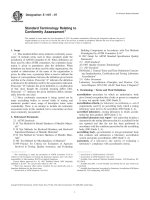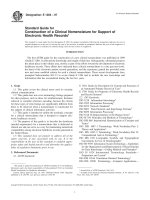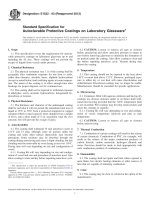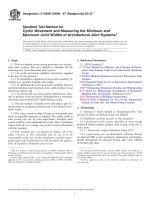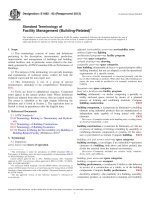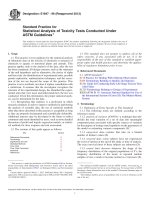Astm e 1403 97 (2013)
Bạn đang xem bản rút gọn của tài liệu. Xem và tải ngay bản đầy đủ của tài liệu tại đây (100.54 KB, 3 trang )
Designation: E1403 − 97 (Reapproved 2013)
Standard Specification for
Laboratory Glass Boiling Flasks1
This standard is issued under the fixed designation E1403; the number immediately following the designation indicates the year of
original adoption or, in the case of revision, the year of last revision. A number in parentheses indicates the year of last reapproval. A
superscript epsilon (´) indicates an editorial change since the last revision or reapproval.
3.1.1.2 Class 2—Ring neck, long neck in the following
sizes: 500 mL, 1 000 mL, 2 000 mL, 6 000 mL, and 12 000 mL.
3.1.1.3 Class 3—Ring neck, long neck, wicker protector in
the following size: 500 mL and 1000 mL.
3.1.1.4 Class 4—Standard Taper $¯ neck, short neck in the
following sizes: 50 mL, 125 mL, 250 mL, 300 mL, 500 mL,
and 1000 mL.
3.1.1.5 Class 5—Standard Taper $¯ neck, long neck in the
following sizes: 250 mL, 500 mL, and 1000 mL.
3.1.2 Type II—Round Bottomed
3.1.2.1 Class 1—Tooled top, long neck in the following
sizes: 25 mL, 50 mL, 100 mL, 250 mL, 500 mL, 1000 mL,
2000 mL, 5000 mL, and 6000 mL.
3.1.2.2 Class 2—Ring neck, short neck in the following
sizes: 250 mL, 500 mL, 1 000 mL, 2 000 mL, 3 000 mL, 5 000
mL, 12 000 mL, and 22 000 mL.
3.1.2.3 Class 3—Standard Taper $¯ neck, short neck in the
following sizes: 5 mL, 10 mL, 25 mL, 50 mL, 100 mL, 250
mL, 500 mL, 1 000 mL, 2 000 mL, 3 000 mL, 5 000 mL, and
12 000 mL.
3.1.2.4 Class 4—Standard Taper $¯ neck, long neck in the
following sizes: 100 mL, 250 mL, 500 mL, and 1000 mL.
3.1.2.5 Class 5—Standard Taper $¯ neck, short neck with
side arm in the following sizes: 250 mL and 300 mL.
3.1.2.6 Class 6—Standard Taper $¯ neck, short neck with
thermometer well in the following sizes: 500 mL, 1000 mL,
and 2000 mL.
3.1.2.7 Class 7—Ball and socket $¯ neck, short neck in the
following sizes 250 mL, 500 mL, 1000 mL, and 2000 mL.
3.1.3 Type III—Heart-shape bottomed
3.1.3.1 Class 1—Standard Taper $¯ neck, short neck in the
following sizes: 5 mL, 10 mL, 25 mL, 50 mL, and 100 mL.
1. Scope
1.1 This specification provides standard dimensional requirements for flat-bottom and round-bottom glass boiling
flasks.
NOTE 1—For packaging standards, choose among the following
standards, E920, E921, E1133, and E1157.
1.2 The values stated in SI units are to be regarded as
standard. No other units of measurement are included in this
standard.
2. Referenced Documents
2.1 ASTM Standards:2
E438 Specification for Glasses in Laboratory Apparatus
E671 Specification for Maximum Permissible Thermal Residual Stress in Annealed Glass Laboratory Apparatus
E676 Specification for Interchangeable Taper-Ground Joints
E677 Specification for Interchangeable Spherical Ground
Joints
E920 Specification for Commercially Packaged Laboratory
Apparatus
E921 Specification for Export Packaged Laboratory Apparatus
E1133 Practice for Performance Testing of Packaged Laboratory Apparatus for United States Government Procurements
E1157 Specification for Sampling and Testing of Reusable
Laboratory Glassware
3. Classification
3.1 Boiling flasks shall be in the following types and sizes.
3.1.1 Type I—Flat bottomed
3.1.1.1 Class 1—Tooled top; long neck in the following
sizes: 50 mL, 125 mL, 250 mL, 500 mL, 1 000 mL, 2 000 mL,
3 000 mL, 6 000 mL, and 12 000 mL.
NOTE 2—The term millilitre (mL) is commonly used as a special name
for the cubic centimetre (cm3 ) and similarly the litre (L) for 1000 cubic
centimetres, in accordance with the International System of Units (SI).
1
This specification is under the jurisdiction of ASTM Committee E41 on
Laboratory Apparatus and is the direct responsibility of Subcommittee E41.01 on
Apparatus.
Current edition approved Nov. 1, 2013. Published December 2013. Originally
approved in 1991. Last previous edition approved in 2008 as E1403 – 97 (2008).
DOI: 10.1520/E1403-97R13.
2
For referenced ASTM standards, visit the ASTM website, www.astm.org, or
contact ASTM Customer Service at For Annual Book of ASTM
Standards volume information, refer to the standard’s Document Summary page on
the ASTM website.
4. Material and Annealing
4.1 Flasks shall be made of borosilicate glass conforming to
the requirement of Type I, Class A of Specification E438.
4.2 Maximum residual thermal stress shall be such as to
conform to Specification E671.
Copyright © ASTM International, 100 Barr Harbor Drive, PO Box C700, West Conshohocken, PA 19428-2959. United States
1
E1403 − 97 (2013)
TABLE 1 Capacity and Dimensions for Glass Boiling Flask
5. Appearance
5.1 The general appearance of the flasks shall be as illustrated in Fig. 1.
Nominal
capacity,
mL
6. Design
6.1 Necks on all single-neck flasks shall be circular in cross
section and perpendicular to the center of the flask body. Neck
lengths may be designated “short” or “long”.
5
10
25
50
100
125
200
250
300
500
1000
2000
3000
5000
6000
12000
22000
6.2 The top shall be strengthened and finished.
6.2.1 Vial finish or tooled top
6.2.2 Beaded rim or ring neck
6.2.3 Standard taper ground glass joint in compliance with
Specification E676
6.2.4 Ball and socket ground glass joint, in compliance with
Specification E677
6.3 Wall thickness minimums are given for all flasks in
Table 1.
6.4 Flat bottoms shall be in a plane perpendicular to the
vertical axis through the neck of the flask.
6.4.1 The bottom of the flask shall be flat, however very
slight concavity is permitted. The flasks shall stand vertically
without rocking or spinning when placed on a level surface.
6.4.2 The diameter of the flat base of the flask shall be 45 to
65 % of the maximum external diameter.
6.4.3 Type I, Class 3 flat-bottomed flasks shall have a
woven wicker insulation collar around the neck.
A
B
Overall Height—Maximum
Without Stopper
Outside
Diameter
Body
Widest
Point max,
mm
StopperA
size
26
32
43
52
66
70
76
87
89
107
134
170
192
223
239
298
352
...
...
1
1
2
2 or 3
5
5
5
6
8
8 or 10
9 or 10
11
11
11
14
Flat
bottom,
mm
Round
bottom,
mm
...
...
...
103
113
122
...
150
150
190
220
295
333
...
375
395
...
52
60
92
108
122
...
130
155
155
210
250
315
260
390
360
385
432
Wall
Heart- thicknessB
shaped
min, mm
bottom,
mm
55
65
80
99
117
...
...
...
...
...
...
...
...
...
...
...
...
0.8
0.8
0.8
0.8
0.8
0.8
0.8
0.8
0.8
0.8
0.8
1.1
1.4
1.5
1.8
2.0
2.5
Rubber stopper style only.
Neck seal zones may be a minimum of 70 % of these values.
6.5.2 Type II, Class 6 round-bottom flasks shall have a
thermometer well within the flask but not open to the content
of the flask.
6.6 Heart-shape-bottomed flasks (sometimes called pear
shaped) shall be shaped to concentrate small amounts of liquid
in the bottom center of the flask.
6.5 Round-bottomed flasks shall be spherical in shape to the
point of juncture with the flask neck.
6.5.1 Type II, Class 5 round-bottom flasks shall have a
side-arm opening to accommodate a thermometer or bleed tube
into the interior of the flask content.
7. Capacity and Dimensions
7.1 The nominal capacity of a flask shall not exceed the
actual capacity to the base of the neck. Dimensions shall
conform to the requirements of Table 1.
8. Sampling and Testing
8.1 See Specification E1157.
9. Product Marking
9.1 Each flask shall be permanently marked with the name
or known trademark of the manufacturer and the nominal
capacity. If applicable, the standard taper or ball and socket
joint size shall be marked on each flask.
9.2 There shall be an area on one side of the flask for
marking with a pencil.
10. Packaging and Package Marking
10.1 Select from one of Specifications E920, E921, and
Practice E1133.
11. Keywords
11.1 boiling; flasks; glass
FIG. 1 General Appearance of Flasks
2
E1403 − 97 (2013)
ASTM International takes no position respecting the validity of any patent rights asserted in connection with any item mentioned
in this standard. Users of this standard are expressly advised that determination of the validity of any such patent rights, and the risk
of infringement of such rights, are entirely their own responsibility.
This standard is subject to revision at any time by the responsible technical committee and must be reviewed every five years and
if not revised, either reapproved or withdrawn. Your comments are invited either for revision of this standard or for additional standards
and should be addressed to ASTM International Headquarters. Your comments will receive careful consideration at a meeting of the
responsible technical committee, which you may attend. If you feel that your comments have not received a fair hearing you should
make your views known to the ASTM Committee on Standards, at the address shown below.
This standard is copyrighted by ASTM International, 100 Barr Harbor Drive, PO Box C700, West Conshohocken, PA 19428-2959,
United States. Individual reprints (single or multiple copies) of this standard may be obtained by contacting ASTM at the above
address or at 610-832-9585 (phone), 610-832-9555 (fax), or (e-mail); or through the ASTM website
(www.astm.org). Permission rights to photocopy the standard may also be secured from the Copyright Clearance Center, 222
Rosewood Drive, Danvers, MA 01923, Tel: (978) 646-2600; />
3
